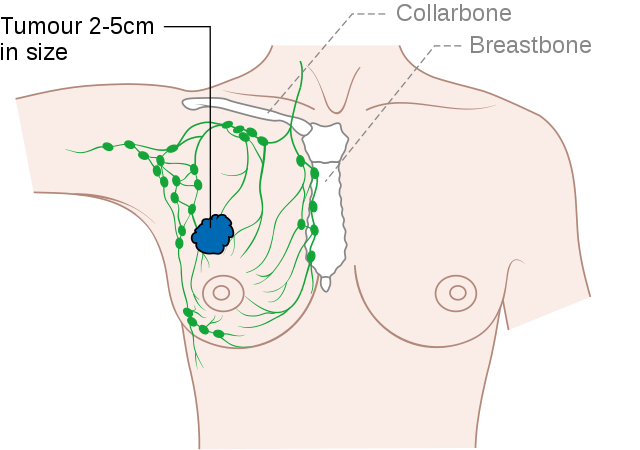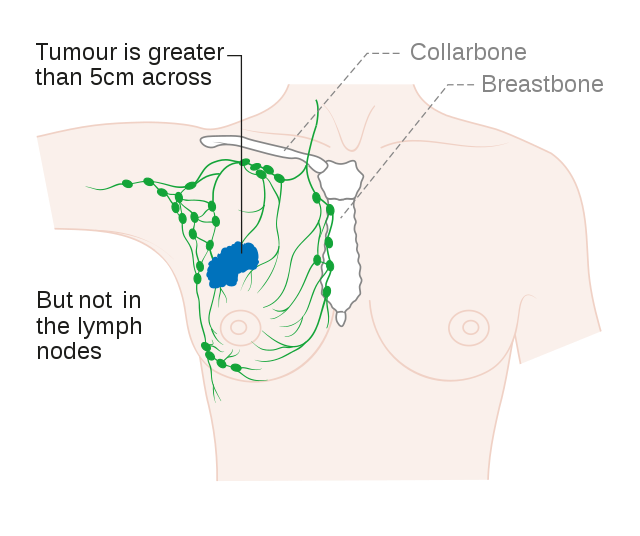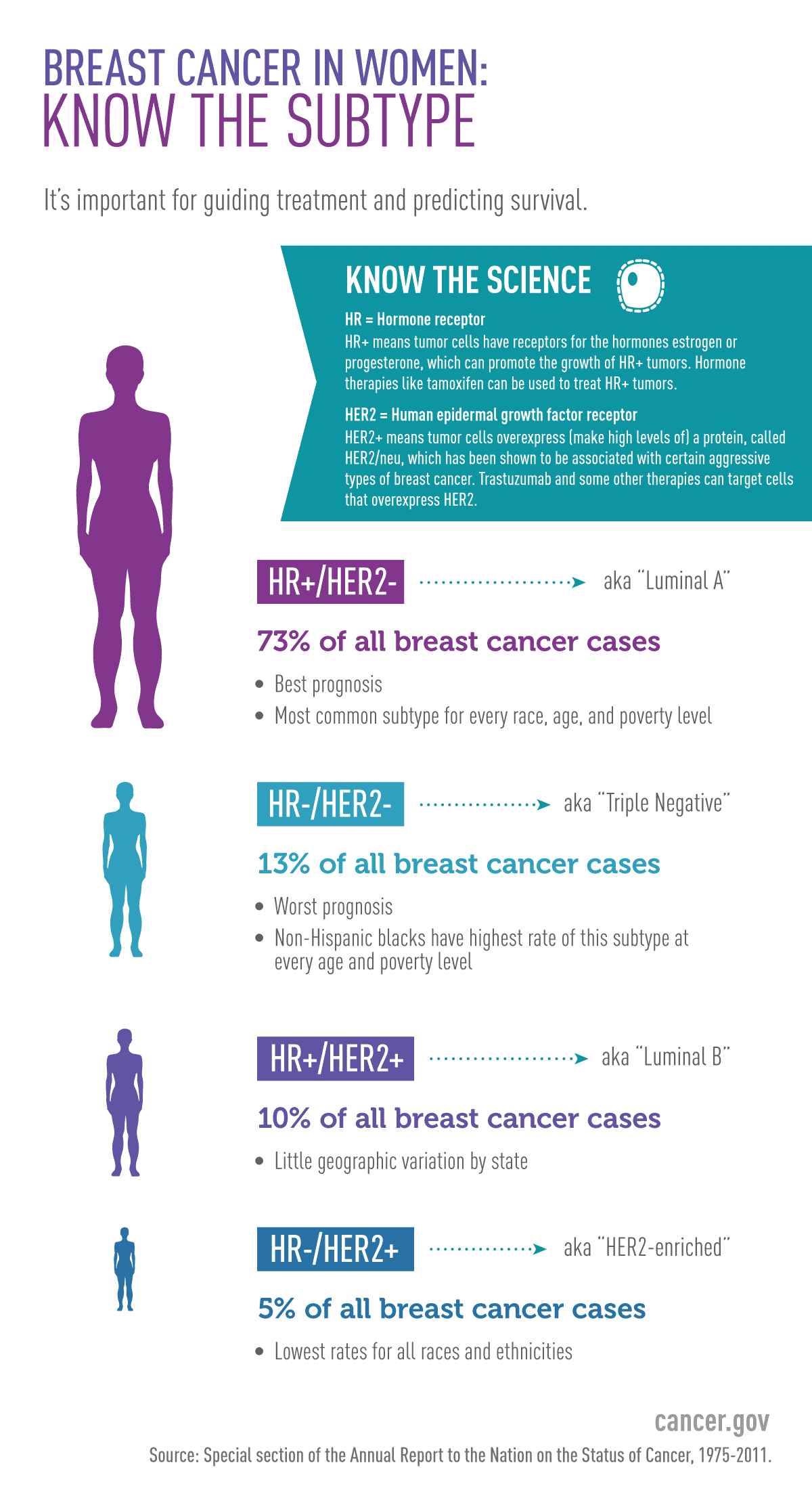Stage 2 Breast Cancer is divided into stages 2A and 2B depending upon the cancer’s size and location. The Stage 2 Breast Cancer survival rate according to the National Cancer Institute is 87% to 99%. Please keep in mind this is an estimate and can vary greatly be person.
Understanding a Stage 2 Breast Cancer diagnosis will help you partner with your doctors to make the best treatment choice for you. Tap “Watch Now” for an easy to understand overview.
- Stage 2A Breast Cancer
- Stage 2B Breast Cancer
- Understanding HR+, HER2, TNBC
Overview
Stage 2A Breast Cancer diagnosis shows up in your body in 1 of 2 ways:
1. The tumor is smaller than 2 centimeters and has spread to the lymph nodes under your arm an area called the Axilla,
or
2. The tumor is larger than 2 centimeters, but smaller than 5 centimeters, about the size of a small lime, without affected your nearby lymph nodes, as shown in the image.
What Tests Will I Need and Why?
Blood and Imaging tests are done to understand your general health, confirm your diagnosis and determine your cancer stage.
Tissue analysis is also typically done to identify your cancer sub-type, which is critical to finding the best treatment option for you. The most common Breast Cancer sub-types are Hormone Receptor Positive, HER2 Positive and Triple Negative (TNBC).
You may also require special Saliva or Blood Analysis to look for specific mutations (actual changes in your body’s DNA), called BRCA1 and BRCA2.
Read this summary as often as needed and then tap, “Compare My Treatment Options Now” to compare your FDA-approved treatment options including, where and how the treatment will be given, what side-effects you may have and most importantly, who can help you pay for your treatment.

Cancer Research U.K. CC BY-SA 4
Overview
Stage 2B Breast Cancer diagnosis shows up in your body in 1 of 2 ways:
1. The tumor is larger than 2 centimeters but smaller than 5 centimeters but it has also spread to the lymph nodes under your arm.
or
2. The tumor is larger than 5 centimeters, about the size of a lime, but has NOT affected your lymph nodes.
What Tests Will I Need and Why?
Blood and Imaging tests are done to understand your general health, confirm your diagnosis and determine your cancer stage.
Tissue analysis is also typically done to identify your cancer sub-type, which is critical to finding the best treatment option for you. The most common Breast Cancer sub-types are Hormone Receptor Positive, HER2 Positive and Triple Negative (TNBC).
You may also require special Saliva or Blood Analysis to look for specific mutations (actual changes in your body’s DNA), called BRCA1 and BRCA2.
Read this summary as often as needed and then tap, “Compare My Treatment Options Now” to compare your FDA-approved treatment options including, where and how the treatment will be given, what side-effects you may have and most importantly, who can help you pay for your treatment.

Cancer Research U.K. CC BY-SA 4
Your Status is critical to identifying the best treatment option for you
In addition to the size and cancer stage, your treatment options are guided by your Hormone Receptor status (+ or -) and HER2 status. Status is identified by analyzing cancer cells taken from the tumor in your breast, a procedure called a Biopsy.
HR positive (HR+)
An HR+ diagnosis means that hormones are fueling the tumor. To understand your specific sub-type, your doctors will look for Estrogen Receptors (ER) and Progesterone Receptors (PR), your tumor can have one, both or neither.
About 70% of breast cancers are HR+.
If you test positive for HR, it means that your treatment should include medications that block hormone production.
HER2 positive (HER2+)
HER2 is a protein that is found in normal cells, it gives cells a signal to grow and produce more cells. A HER2 positive (+++) breast cancer diagnosis means that the tumor cells have too many HER2 proteins, causing uncontrolled tumor cell division, tumor growth and spreading.
About 15% of all breast cancer tumors are HER2 positive (+++). Some patients with HR+ can also have HER2 positive (+++).
If you test HER2+, it means that your treatment should include medications that block the HER2 protein to stop tumor cell growth.
Triple Negative (TNBC) (aka HER2-/HR-)
A TNBC diagnosis means that analysis of your cancer cells has shown that negative results for 3 key breast cancer “fuels”:
- Estrogen Receptors (ER)
- Progesterone Receptors (PR)
- Too much HER2 Protein
TNBC is a type of fast-growing breast cancer that occurs in about 13% of all breast cancers.
If you are diagnosed with TNBC+, it means that your treatment should include chemotherapy in most cases, and for some women Immunotherapy.

Recommended Breast Cancer Videos

Stage 2 Breast Cancer
A Helpful Introduction from Dr. Jennifer Griggs

Stage 2 Breast Cancer
A Helpful Introduction from Dr. Jennifer Griggs

How Cancer Spreads
Metastatic = Advanced

Diagnosing Your Cancer
How Does a CT Scan Work?

Diagnosing Your Cancer
How Does a PET Scan Work?

Exercise! You Can Do It
Reducing Side Effects & More
Answers To The Most Searched Questions
Stage 2 Breast Cancer Definition
Stage 2 means the breast cancer is growing, but it is still contained in the breast or growth has only extended to the nearby lymph nodes.
This stage is divided into groups: Stage 2A and Stage 2B. The difference is determined by the size of the tumor and whether the breast cancer has spread to the lymph nodes.
Source: Cancer.org
Stage 2 Breast Cancer Survival Rate
Overall, the prognosis for stage 2 breast cancer is generally good. According to SEER data, the 5-year relative survival rate is:
- 99.1% for localized breast cancer (has not spread outside the breast)
- 86.1% percent for regional breast cancer (spread to nearby lymph nodes)
Source: Cancer.gov
Stage 2 Breast Cancer Treatment
It involves surgery and some patients may need chemotherapy, radiotherapy, hormone therapy, or targeted therapy. Now click here to Compare Your Latest Treatment Options.
Source: Cancer.org
Stage 2 Breast Cancer Recurrence Rate
In women who have breast-conserving treatment, the chance of recurrence is about 3%-15% in 10 years, depending on tumor characteristics and margins. Distant recurrence in those who had a mastectomy is most influenced by axillary lymph node involvement. When axillary lymph nodes are not cancerous, the recurrence rate is 6% in 5 years. When axillary lymph nodes are cancerous, the recurrence rate is 23% in 5 years with a mastectomy but no radiation.
Source: My.clevelandclinic.org
Stage 2 Breast Cancer Symptoms
These are some of the symptoms of Stage 2 Breast Cancer:
- Skin irritation or dimpling
- Lump in the breast
- Swelling of all or part of the breast
- A change in the size or the shape of the breast
- Nipple turning inward or change in the appearance of a nipple
- Nipple pain
- Nipple discharge that is not breast milk
Source: Cancer.org
Stage 2 Breast Cancer Prevention
Prevention strategies for Stage 2 breast cancer include:
- Regular Screening: Follow mammogram and clinical breast exam guidelines.
- Healthy Lifestyle: Maintain a healthy weight, exercise regularly, and eat a balanced diet.
- Limit Alcohol: Keep alcohol intake to no more than one drink per day.
- Avoid Tobacco: Do not smoke.
- Manage Hormones: Discuss hormone replacement therapy with your doctor.
- Genetic Counseling: For those with a strong family history or genetic mutations, consider additional preventive measures.
Source: Cancer.org














